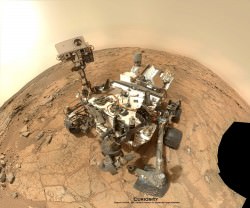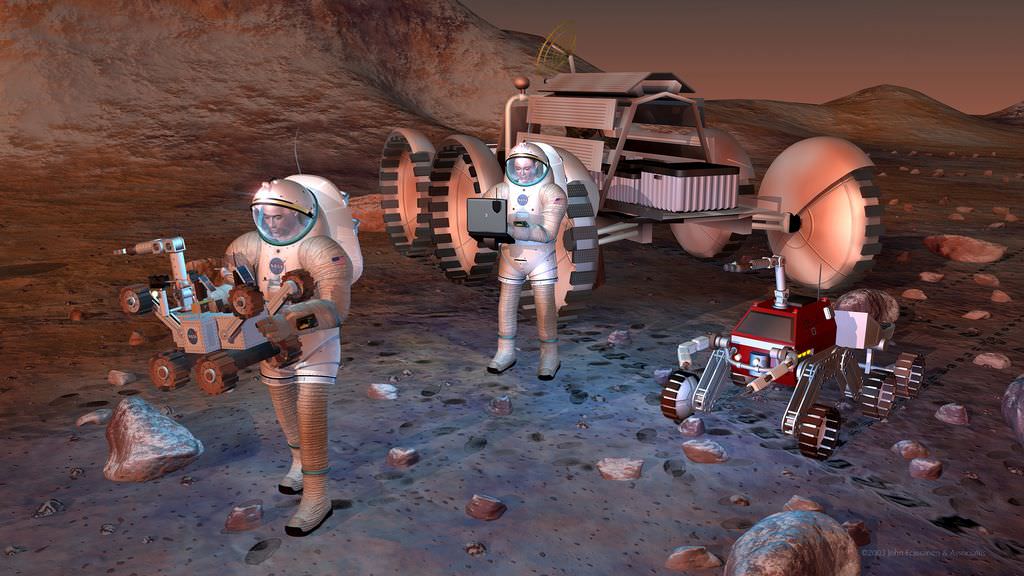While asking questions about habitability on Mars, one thing that scientists also need to consider is whether it’s safe enough for humans to even do exploration there. Radiation is definitely a big factor — in a press conference yesterday (Dec. 9) for the American Geophysical Union’s conference, scientists said the environment is unlike anything we are used to naturally on Earth.
Radiation on Mars comes from two sources: galactic cosmic rays (over the long term) and solar energetic particles (in short bursts of activity when the sun gets super-active). Of note, the sun has had a muted peak to its solar cycle, so that’s affecting the expected amount of particles on Mars. But the Mars Curiosity rover, in its first 300 Earth days of roaming, has plenty of data on galactic cosmic rays.
On the Martian surface, the average dose is about 0.67 millisieverts (mSv) per day, at least between the measurement period of August 2012 and June 2013. The journey to Mars had a dose of 1.8 mSv per day inside the spaceship. So what does that means for NASA’s human health consideration concerns?

With a 500-day trip on the surface and the journey to and from Mars (which would take 180 days each way), NASA is saying the total dosage for the mission would be about 1 Sv. Population studies over the long term have shown that increases the fatal cancer risk by 5%. Current NASA guidelines for low-Earth orbit don’t allow for a more than 3% increase, but 1 Sv is within the guidelines for several other space agencies.
But don’t rule out the trip to Mars yet, NASA states: “[NASA] does not currently have a limit for deep space missions, and is working with the National Academies Institute of Medicine to determine appropriate limits for deep space missions, such as a mission to Mars in the 2030s.”
Besides, other entities are thinking about going, such as Mars One.
Read more about the radiation findings in this Dec. 9 article on Science. The research was led by Don Hassler, a Southwest Research Institute program director and principal investigator of Curiosity’s radiation assessment detector (RAD).
Source: Southwest Research Institute


You still have to shield astronauts against the possibility of a major solar event occurring during the multi-year mission. But appropriately shielding astronauts against solar events also has the mutual benefit of significantly reducing cosmic radiation exposure.
There’s also no logical reason why pre-deployed outpost on the Martian surface can’t be– fully protected- from excessive amounts of cosmic radiation since there is an endless amount of regolith on the surface of Mars that could be easily used for radiation shielding.
Marcel F. Williams
simply putting the sleeping quarters and bathrooms in a heavily shielded area of the habitat reduces the exposure by 1/3rd.
But you still need to reduce exposure to cosmic rays in general– especially during the solar minimum. So the entire living area of the habitat should probably be shielded with at least 50 centimeters of water if you want to protect against solar events while also reducing cosmic radiation exposure by about 2/3rds.
Marcel
Yeah but on Mars, your risk of death from Horse kicks, Snake bites, lighting strikes, Malaria, crossing the street or mass shootings etc. looks far more acceptable.
Sign me up.
It’s 2013 and this is the “artist’s conception” we still get?
It really is not that difficult to protect people from radiation. Seriously, if you want to leave the planet, that might be something you want to work on. Wouldn’t want anyone’s cancer risk to go up 5%.
The “5% increased risk” might refer to developing a tumor, including benign tumors, at some point during the average life span which is 76 years for a US male and 81 years for a US female.
So, avoid going to Mars as a child. Wait till your mid 50s or later minimizing any head start pre-cancerous cells might get from space flight.
If there’s family history of susceptibility to cancers, then chose to die here on Earth with everyone else.
An increased risk of cancer can be managed provocatively with more frequent check-ups. The Astronaut Corp have a bullet proof healthcare plans.
I’m picking there’ll be no shortage of volunteers for the trip to Mars. 🙂
It clearly says that the 5% increased risk is that of developing a fatal cancer.
Thanks for that Hunter. I didn’t have a subscription to the source document.
Cheers.